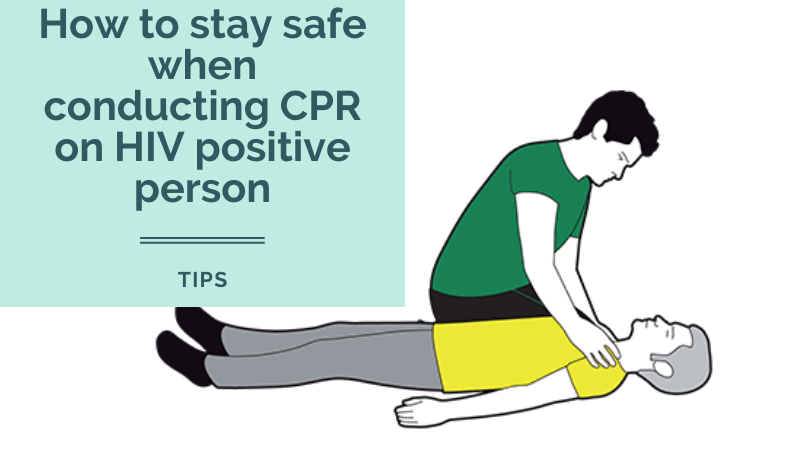
Despite the global commitment to control HIV infections, the virus has continued to spread at an alarming rate. Not even doctors and nurses attending to HIV-positive patients are spared unless they adhere to safety measures for handling infected persons.
When attending to patients of any kind, Cardiopulmonary resuscitation (CPR) patients included, health facilitators must ensure they stay safe from any infections under all circumstances. You may not know who is positive until a HIV test is done. Therefore, you have to practice safe measures especially when handling emergency support like CPR.
What does CPR involve?
Cardiopulmonary resuscitation (CPR) is an emergency procedure that consists of chest compressions and artificial ventilation with an effort to maintain oxygenation and blood circulation. An example is during a cardiac arrest.
Besides, it aims to manually facilitate intact brain activities until professional measures are taken to restore a person’s breathing and blood flow.
I’m sure you know how HIV spreads, and now you are wondering how CPR or cardiac arrest relates to HIV infections.
That’s why you have to read this article to the end!
This is how you can get exposed to HIV when conducting CPR
Have you ever come across someone unconscious and not breathing or gasping occasionally? Maybe a person rescued from drowning would be a better example to use.
I don’t mean that’s the only example of cardiac arrest cases. But definitely one of the common causes of sudden cardiac arrest most people might experience.
When you find someone who isn’t breathing, or is only gasping, what do you do?
I believe you are thinking of doing chest compression and opening the airway for them by covering their mouths with yours. In other words, mouth to mouth to create an airtight seal.
You are correct, and that is what a trained CPR would do- a good move in saving the person’s life. But first, you must assess whether the victim requires Cardiopulmonary resuscitation (CPR) and that what they are experiencing is not a heart attack but rather a cardiac arrest.
Now, here is how CPR increases your chances of getting infected.
Direct conduct with the victim’s open wounds
I’m reasonably sure that you are well conversant with the methods of HIV transmission-non sexual transmission included. If that’s the case then, you must be aware of the effects of open wounds and blood exposure in HIV spread.
In the process of administering artificial ventilation to a Cardiopulmonary resuscitation (CPR) HIV-positive patient, you may get infected, especially when you have an open wound. For instance, in the event of covering the victim’s mouth with yours, you and the victim may be having open wounds on your mouths.
Also, a person might have fallen and bled out in their unconscious state. And your compulsion may overpower you to help them out without considering your safety.
And when your open wounds or oral sores are exposed to the blood that contains HIV, you are likely to get infected. In fact, according to the National Native HIV Network, the virus can spread through contact between broken skin wounds or mucous membrane and HIV infected blood or blood contaminated body fluids. That means opening the airway for a CPR patient through the mouth to mouth ventilation increases the chances of HIV infection.
Tips to help you stay safe when conducting CPR on HIV positive patient
The most important thing you must avoid is having direct contact with the victim’s blood. Therefore, you must:
Always uphold standard precautions
Dealing with cardiac arrest patients or any other patients, especially those living with HIV, requires you to maintain high standards of precautions. The measures are to minimize the spread of healthcare associated infections.
Better still, avoid any direct contact with blood and secretions. To do this, you must ensure you;
All times used disposable gloves.
You never know when you can get in contact with blood or body fluids from an infected person.
Therefore;
- Wear gloves when you have open and healing wounds or suspects a skin infection and cover any cuts, sores, or exposed skin.
- When you are conducting any Cardiopulmonary resuscitation procedures
- When in contact with surfaces contaminated with blood
Besides, ensure you wash your hands with soap and water after any CPR procedures or contact with blood, even if you wear gloves.
Suppose you are a doctor or nurse, you must ensure you carefully handle needles and lancets used during treatment to avoid sticking yourself. Similarly, you are to take any used item like syringes with a lot of care.
Conclusion.
Attending to patients requires some esteemed preparations and precautions. For persons living with HIV, you must uphold some standard infection control measures to prevent any spread of the virus, especially in emergencies like during Cardiopulmonary resuscitation (CPR). You must ensure there is no direct contact with the infected person’s blood.
Therefore, ensure you wear gloves, wash your hands with soap and water immediately after attending to patients, especially when you come in contact with blood. You must always ensure you treat patients with a lot of precautions. You never know when you may get exposed to infections.


